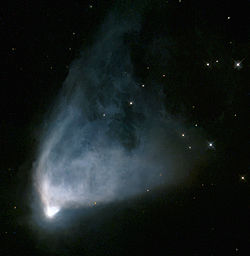| Observation data Epoch J2000 Equinox J2000 | |
|---|---|
| Constellation | Monoceros |
| Right ascension | 06h 39m 09.954s[1] |
| Declination | +08° 44′ 09.56″[1] |
| Apparent magnitude (V) | 11.85[2] |
| Characteristics | |
| Spectral type | B8IIIev[3] |
| Variable type | Herbig Ae/Be star[2] |
| Astrometry | |
| Distance | 2600 ly (800[4] pc) |
| Details | |
| Mass | ~2–10[5] M☉ |
| Age | ~105 yr[5] years |
| Other designations | |
| Database references | |
| SIMBAD | data |
R Monocerotis, abbreviated R Mon, is a very young binary star[5] system in the equatorial constellation of Monoceros. The apparent magnitude of R Mon varies between 10 and 12 and the spectral type is B8IIIe.[3]

This is a massive Herbig Ae/Be star, a type of pre-main-sequence star that is surrounded by an orbiting circumstellar disk of gas and dust. This disk has a mass of ~0.007 M☉ and extends outward to a distance of under 150 AU from the host. Because of this dust, the star is obscured from direct visual sight but can still be observed in the infrared.[5] R Mon is still in the accretion phase of star formation and it is driving an optically opaque bipolar outflow with a velocity of 9 km/s. The northern flow is blue-shifted, and thus moving more toward the Sun.[7] There is a T Tauri-type stellar companion at an angular separation of 0.69″ from the primary.[5]
This system is located in a diffuse nebula called "Hubble's Variable Nebula" (NGC 2261), which is being illuminated by a conical beam of light from the primary.[5]
References
[edit]- ^ a b Brown, A. G. A.; et al. (Gaia collaboration) (August 2018). "Gaia Data Release 2: Summary of the contents and survey properties". Astronomy & Astrophysics. 616. A1. arXiv:1804.09365. Bibcode:2018A&A...616A...1G. doi:10.1051/0004-6361/201833051. Gaia DR2 record for this source at VizieR.
- ^ a b c "R Mon". SIMBAD. Centre de données astronomiques de Strasbourg. Retrieved 26 December 2016.
- ^ a b Mora, A.; et al. (2001). "EXPORT: Spectral classification and projected rotational velocities of Vega-type and pre-main sequence stars". Astronomy and Astrophysics. 378: 116–131. Bibcode:2001A&A...378..116M. doi:10.1051/0004-6361:20011098.
- ^ Manoj, P. (2006). "Evolution of Emission-Line Activity in Intermediate-Mass Young Stars". The Astrophysical Journal. 653 (1): 657–674. arXiv:astro-ph/0608541. Bibcode:2006ApJ...653..657M. doi:10.1086/508764. S2CID 17545474.
- ^ a b c d e f Fuente, A.; et al. (October 2006). "A Keplerian Gaseous Disk around the B0 Star R Monocerotis". The Astrophysical Journal. 649 (2): L119 – L122. arXiv:gr-qc/0608088. Bibcode:2006ApJ...649L.119F. doi:10.1086/508349. S2CID 18763481.
- ^ "ASAS All Star Catalogue". The All Sky Automated Survey. Retrieved 8 December 2021.
- ^ Sandell, Göran; et al. (February 2020). "The Molecular Outflow from R Mon". The Astrophysical Journal. 889 (2): 9. Bibcode:2020ApJ...889..138S. doi:10.3847/1538-4357/ab6593. S2CID 213902084. 138.
Further reading
[edit]- Murakawa, K.; et al. (September 2008). "VLT/NACO and Subaru/CIAO JHK-band high-resolution imaging polarimetry of the Herbig Be star R Monocerotis". Astronomy and Astrophysics. 488 (3): L75 – L78. Bibcode:2008A&A...488L..75M. doi:10.1051/0004-6361:200810462.
